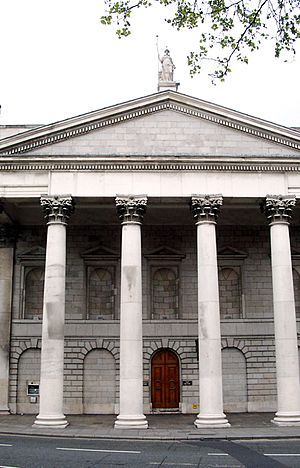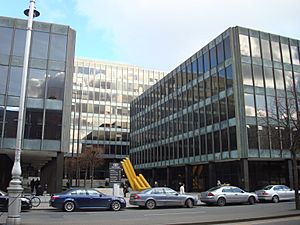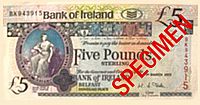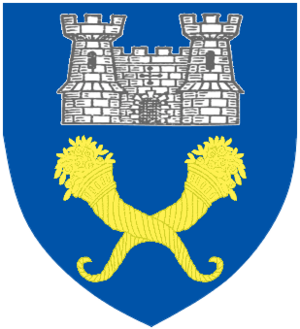Bank of Ireland facts for kids
| Public limited company | |
| Traded as | Euronext Dublin: BIRG ISEQ 20 component |
| ISIN | ISIN: [https://isin.toolforge.org/?language=en&isin=IE00BD1RP616 IE00BD1RP616] |
| Industry |
|
| Founded | 5 April 1783 |
| Headquarters | Ballsbridge, Dublin, Ireland |
|
Area served
|
|
|
Key people
|
|
| Products |
|
| Revenue | €4,247 million (2022) |
|
Operating income
|
€3,234 million (2022) |
| €1,345 million (2022) | |
|
Number of employees
|
9,074 (2022) |
Bank of Ireland Group plc (Irish: Banc na hÉireann) is a commercial bank operation in Ireland and one of the traditional Big Four Irish banks. Historically the premier banking organisation in Ireland, the bank occupies a unique position in Irish banking history. At the core of the modern-day group is the old Governor and Company of the Bank of Ireland, the ancient institution established by royal charter in 1783.
Contents
History
Bank of Ireland is the oldest bank in continuous operation (apart from closures due to bank strikes in 1950, 1966, 1970, and 1976) in Ireland.
In 1781, the Bank of Ireland Act was passed by the Parliament of Ireland, establishing Bank of Ireland. On 25 June 1783, Bank of Ireland opened for business at Mary's Abbey in a private house previously owned by one Charles Blakeney.
On 6 June 1808, Bank of Ireland moved to 2 College Green. By 1827, it had seven branches outside of Dublin, in Belfast, Clonmel, Cork, Derry, Newry, Waterford and Westport.
In 1864, Bank of Ireland paid its first interest on deposits.
By 1883, Bank of Ireland had 58 branches throughout Ireland, and by 1920, the number had grown to 75.
In 1922, Bank of Ireland was appointed as banker to the Government of Ireland.
In 1926, Bank of Ireland took control of the National Land Bank. In 1948, The Bank of Ireland 1783–1946 by F.G. Hall was published jointly by Hodges Figgis (Dublin) and Blackwell's (Oxford).
In 1958, the Bank took over the Hibernian Bank Limited. In 1965, The National Bank Ltd, a bank founded by Daniel O'Connell in 1835, had branches in Ireland and Britain. The Irish branches were acquired by Bank of Ireland and rebranded temporarily as National Bank of Ireland, before being fully incorporated into Bank of Ireland. The British branches were acquired by Williams & Glyn's Bank.
In 1965, Bank of Ireland acquired the National Bank Ltd (changing its name to the National Bank of Ireland Ltd). In 1969, Bank of Ireland, Hibernian Bank and the National Bank of Ireland were merged to form the Bank of Ireland Group.
In 1980, Bank of Ireland opened its first ATM (branded as Pass Machines). In 1983, Bank of Ireland celebrated its Bi-Centenary and a commemorative stamp was issued. The Bank also commissioned the publication of "An Irish Florilegium" that year. In 1995, Bank of Ireland merged First New Hampshire Bank with Royal Bank of Scotland's Citizens Financial Group. Only branches in cities and major towns had ATMs in the 1980s but branches in most medium and small towns installed then in the 1990s.
In 1990, Bank of Ireland offered Visa cards for the first time. In 1996, it introduced telephone banking.
In 1996, Bank of Ireland bought the Bristol and West building society for UK£600 million (€882 million), which kept its own brand. In 1997, Bank of Ireland acquired New Ireland Assurance plc.
In 1997, Bank of Ireland introduced internet banking.
In 1999, the bank held merger talks with Alliance & Leicester, but they were called off. In 2000, it was announced that Bank of Ireland was acquiring Chase de Vere. This share was later sold in 2004.
In 2001, the bank acquired Moneyextra. In 2002, it acquired a 61% share in Iridian, a US investment manager, which doubled the size of its asset management business. It increased its share to 76% in 2004. In 2005, Bank of Ireland completed the sale of the Bristol and West branch and Direct Savings (Contact Centre) to Britannia Building Society.
In 2008, Moody's Investors Service changed its rating of Bank of Ireland from stable to negative. Moody's pinpointed concerns over weakening asset quality and the impact of a more challenging economic environment on profitability at Bank of Ireland. A share price collapse followed. In 2009, The Irish government announced a €7 billion rescue package for the bank and Allied Irish Banks plc in February. The biggest bank robbery in the history of the state took place at Bank of Ireland at College Green. Consultants Oliver Wyman validated Bank of Ireland's bad debt levels at €6 billion over three years to March 2011, a bad debt level which was exceeded by almost €1 billion within a matter of months.
In 2010, The European Commission ordered the disposal of Bank of Ireland Asset Management, New Ireland Assurance, ICS Building Society, its US Foreign Exchange business and the stakes held in the Irish Credit Bureau and in an American Asset Manager followed the receipt of Irish Government State aid. In 2011, the Securities Services Division of the bank was sold to Northern Trust Corporation.
In 2013, Bank of Ireland more than doubled interest rates on mortgages tracking Bank of England rates, (which had remained stable for four years), citing the need to hold more reserves and the 'increased cost of funding mortgages'. Described by Ray Boulger of broker John Charcol as 'having shot the reputation of its mortgages to smithereens', nevertheless, the bank continues to offer highly competitive mortgages through the Post Office.
In 2014, regulation of the bank was transferred to the European Central Bank. Also in 2014, the bank entered into a marketing alliance with EVO Payments International and re-entered the card acquiring market. BOI Payment Acceptance was launched in December 2014.
In September 2022, the Irish state sold its remaining shareholding in the bank to return it to fully private ownership for the first time in a decade.
Role as government banker
Bank of Ireland is not, and was never, the Irish central bank. However, as well as being a commercial bank – a deposit-taker and a credit institution – it performed many central bank functions, much like the earlier-established Bank of Scotland and Bank of England. Bank of Ireland operated the Exchequer Account and during the nineteenth century acted as something of a banker of last resort. Even the titles of the chairman of the board of directors (the Governor) and the title of the board itself (the Court of Directors) suggest a central bank status. From the foundation of the Irish Free State in 1922 until 31 December 1971, Bank of Ireland was the banker of the Irish Government.
Headquarters

The headquarters of the bank until the 1970s was the impressive Parliament House on College Green, Dublin. This building was originally designed by Sir Edward Lovett Pearce in 1729 to host the Irish Parliament, and it was the world's first purpose-built bicameral parliament building.
The bank had planned to commission a building designed by Sir John Soane to be constructed on the site bounded by Westmoreland Street, Fleet Street, College Street and D'Olier Street (now occupied by the Westin Hotel). However, the project was cancelled following the Act of Union in 1800, when the newly defunct Parliament House was bought by Bank of Ireland in 1803. The former Parliament House continues today as a working branch. Today, visitors can still view the impressive Irish House of Lords chamber within the old headquarters building. The Oireachtas, the modern parliament of Ireland, is now housed in Leinster House in Dublin. In 2011, the Irish Government set out proposals to acquire the building as a venue for the state to use as a cultural venue.
In the 1970s the bank moved its headquarters to a modern building, now known as Miesian Plaza, on Lower Baggot Street, Dublin 2. As Frank McDonald notes in his book Destruction of Dublin, when these headquarters were built, it caused the world price of copper to rise – such was the usage in the building.
In 2010 the bank moved to its current, smaller headquarters on Mespil Road.
Banking services
Bank of Ireland is headquartered in Dublin, and has operations in the Republic of Ireland, Northern Ireland, Great Britain and elsewhere.
Republic of Ireland
The Group provides a broad range of financial services in Ireland to the personal, commercial, industrial and agricultural sectors. These include checking and deposit services, overdrafts, term loans, mortgages, international asset financing, leasing, instalment credit, debt financing, foreign exchange facilities, interest and exchange rate hedging instruments, executor and trustee services.
At its height in 1969, Bank of Ireland had 500 branches in the Republic of Ireland. By 2022, the number of branches had gradually been cut to 169.
Northern Ireland
In Northern Ireland, Bank of Ireland prints its own banknotes in Pounds Sterling (see section on banknotes below).
In 2021, the number of branches in Northern Ireland was cut from 28 to 13.
Great Britain
In Great Britain, the bank expanded largely through the takeover of the Bristol and West Building Society in 1996. Bank of Ireland also provides financial services for the British Post Office throughout the UK and AA Savings.
Rest of world
Operations in the rest of the world are primarily undertaken by Bank of Ireland Corporate Banking who provide services in France, Germany, Spain and the United States.
Banknotes
Although the Bank of Ireland is not a central bank, it does have sterling note-issuing rights in the United Kingdom. While the Bank has its headquarters in Dublin, it also has operations in Northern Ireland, where it retains the legal right (dating from before the partition of Ireland) to print its own banknotes. These are pound sterling notes and equal in value to Bank of England notes, and should not be confused with banknotes of the former Irish pound.
The obverse side of Bank of Ireland banknotes features the Bank of Ireland logo, below which is a line of heraldic shields each representing one of the six counties of Northern Ireland. Below this is a depiction of a seated Hibernia figure, surrounded by the Latin motto of the Bank, Bona Fides Reipublicae Stabilitas ("Good Faith is the Cornerstone of the State"). The current series of £5, £10 and £20 notes, issued in April 2008, all feature an illustration of the Old Bushmills Distillery on the reverse side. Prior to 2008, all Bank of Ireland notes featured an image of the Queen's University of Belfast on the reverse side.
The principal difference between the denominations is their colour and size:
- £5 note, blue
- £10 note, pink
- £20 note, green
- £50 note, blue-green
- £100 note, red.
The Bank of Ireland has never issued its own banknotes in the Republic of Ireland. Section 60 of the Currency Act 1927 removed the right of Irish banks to issue banknotes, however "consolidated banknotes", of a common design issued by all "Shareholder Banks" under the Act, were issued between 1929 and 1953. These notes were not legal tender.
On 5 March 2009, the shares reached €0.12 during the day, thereby reducing the value of the company by over 99% from its 2007 high. At the 2009 AGM, shareholders criticised the performance of their Auditors, PriceWaterhouseCoopers.
The Central Bank told the Oireachtas Enterprise Committee that shareholders who lost their money in the banking collapse were to blame for their fate and got what was coming to them for not keeping bank chiefs in check, but did admit that the Central Bank had failed to give sufficient warning about reckless lending to property developers.
Arms





